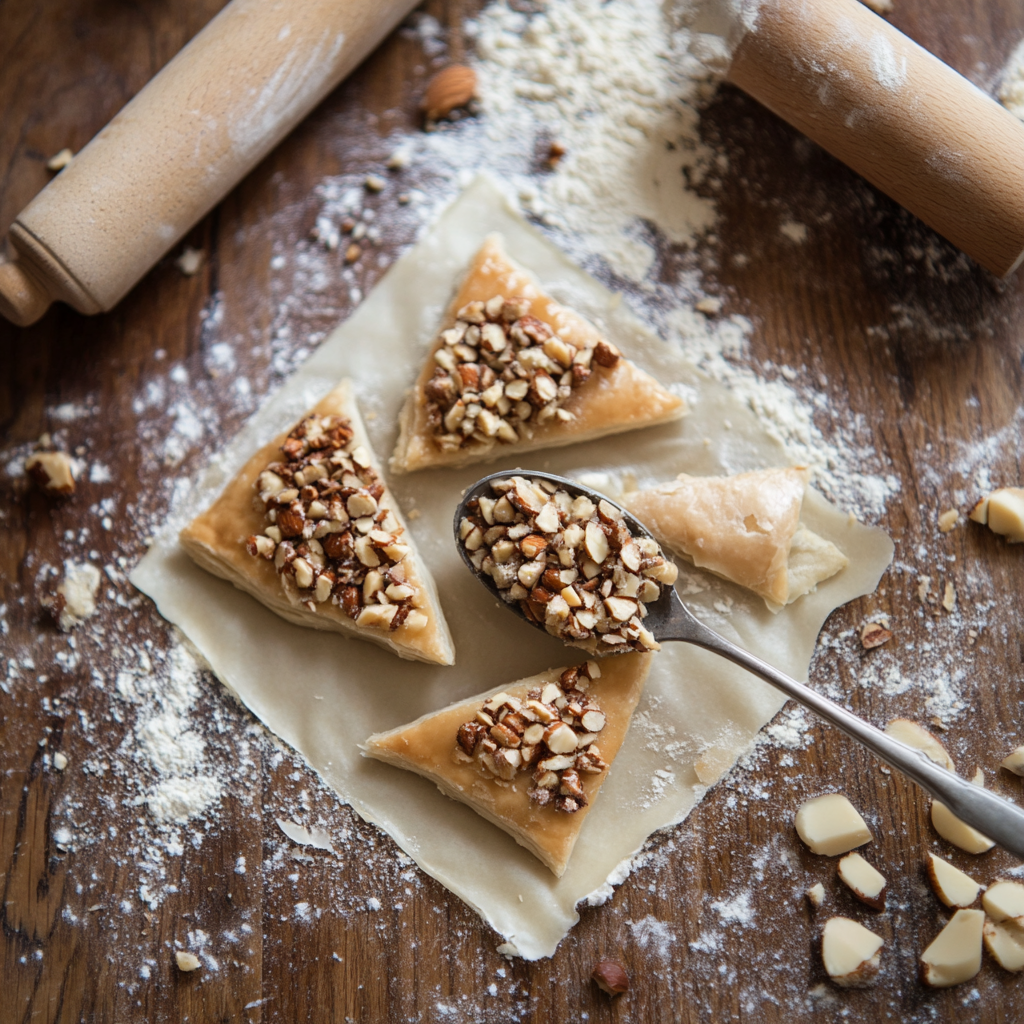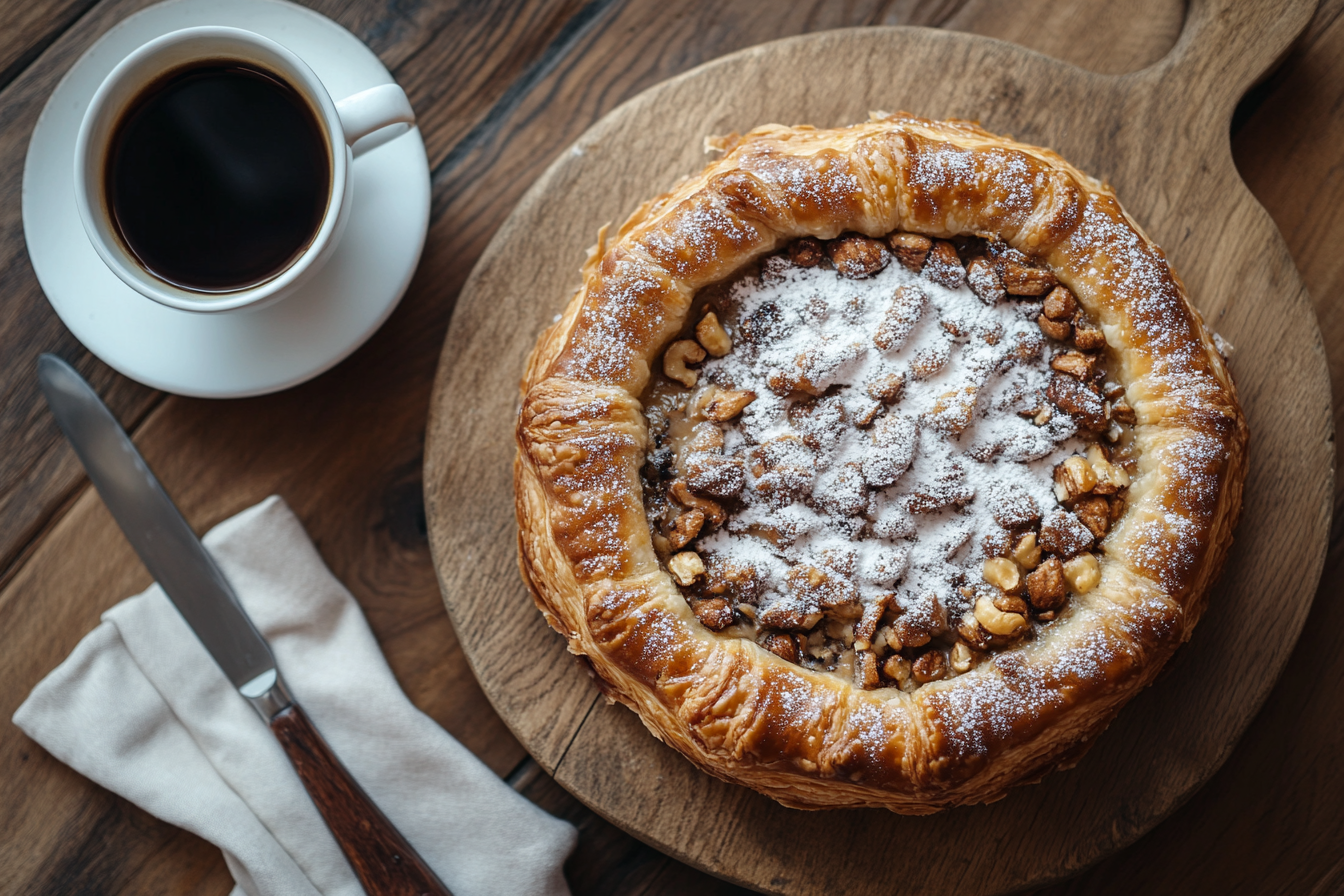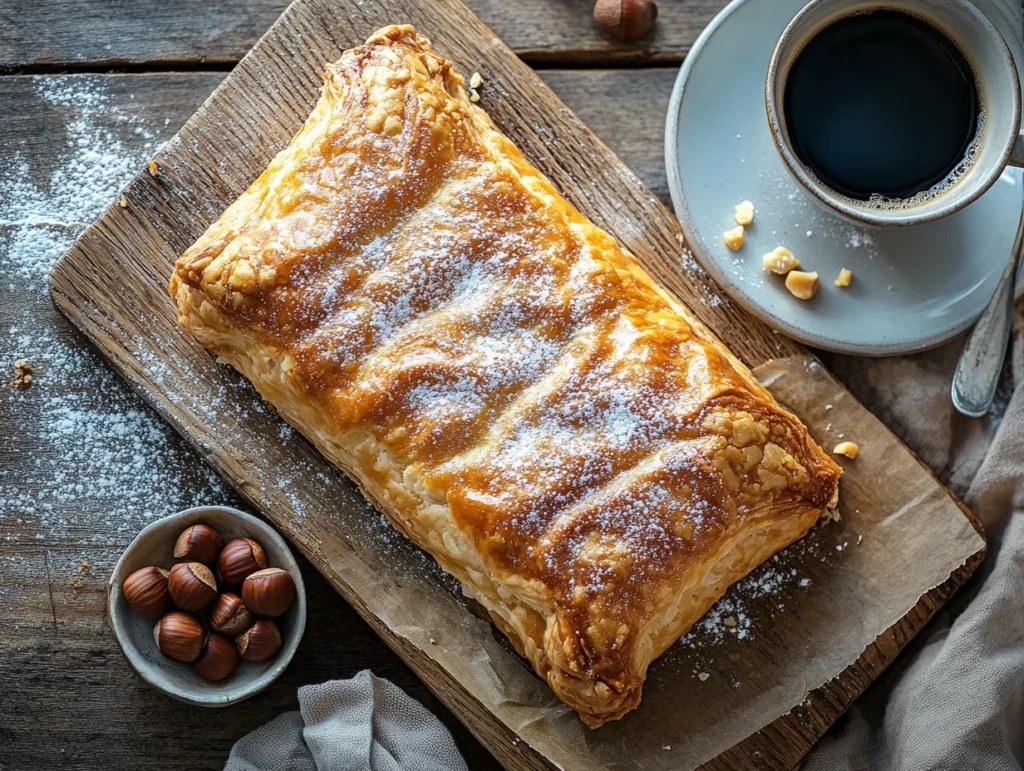Imagine sitting in a cozy Swiss café, sipping coffee and savoring every bite of a buttery, flaky, nut-filled pastry known as a Nussgipfel. This pastry isn’t just your average breakfast item; it’s a delicious piece of Swiss tradition and culinary art. Whether you’re a home cook, a busy parent, or simply someone who enjoys exploring new flavors, this guide will walk you through everything you need to know about the Nussgipfel—from its rich history and ingredients to how you can bake this delightful treat in your own kitchen.
At Kai Recipes, we believe that cooking should be both enjoyable and accessible, a way to create lasting memories around the table. Baking a batch of Nussgipfel is a simple yet rewarding way to bring a little slice of Swiss culture into your home. And trust me, once you taste that flaky, buttery crust paired with the sweet, nutty filling, stopping at just one will be impossible!
So, what exactly is a Nussgipfel? Let’s dive into its origins, recipe, and some tips to help you perfect this Swiss classic!
What is a Nussgipfel?
A Nussgipfel is a traditional Swiss pastry, crescent-shaped and filled with a sweet nut mixture, typically made from almonds or hazelnuts. The name “Nussgipfel” comes from two German words: “Nuss,” meaning nut, and “Gipfel,” meaning peak or summit, which, as you can see, reflects its crescent shape. In many ways, you can think of it as the nutty cousin of the French croissant, but with a unique Swiss twist.
The exterior is flaky, buttery, and crisp, all thanks to the puff pastry layers. Inside, you’ll find a rich, spiced nut filling that contrasts perfectly with the crispy outer layers. Whether you enjoy it warm from the oven, topped with a drizzle of icing, or paired with a hot cup of coffee, the Nussgipfel offers both comfort and indulgence in every bite.
More than that, the Nussgipfel is not just a breakfast item; it’s a Swiss culinary treasure, embodying the country’s dedication to high-quality baked goods. So, curious how it compares to a croissant? Let’s explore the differences!
The Origins of This Nut-Filled Pastry
The Nussgipfel has deep roots in Swiss pastry culture, which has long been shaped by the influences of neighboring countries like France, Austria, and Germany. While the French are renowned for their buttery croissants, Switzerland has its own version of crescent-shaped pastries, such as Gipfeli—a denser, less buttery take on the croissant—and the Nussgipfel, which, in contrast, stands out with its rich nut filling.
Historically, nuts like almonds and hazelnuts were plentiful in Swiss regions, inspiring bakers to incorporate them into their recipes. Over time, Nussgipfel became a beloved breakfast favorite and a popular snack for both travelers and locals. Moreover, Swiss bakeries, especially in regions like the Bernese Oberland, have perfected the art of crafting high-quality Nussgipfel, passing down traditional baking techniques from generation to generation.
Swiss pastries, particularly the Nussgipfel, reflect the country’s commitment to quality ingredients and meticulous attention to detail. The lamination process used to make the dough results in layers of flaky, buttery goodness, while the sweet nut filling provides the perfect balance. To truly appreciate the significance of this pastry, learning more about its Swiss origins helps you understand why it holds such a cherished place in Swiss culinary traditions.
Comparing Nussgipfel with Croissants
At first glance, you might confuse a Nussgipfel with a French croissant because of their similar crescent shape. However, they differ in several important ways:
- Filling: Croissants are typically plain or filled with chocolate or almond paste. In contrast, Nussgipfel always has a nutty filling, usually made from hazelnuts or almonds, mixed with sugar, and sometimes fruits like apple or orange zest.
- Texture: Croissants are light and airy, thanks to their high butter content. On the other hand, Nussgipfel is denser and heartier, though still layered. This gives it a more substantial, satisfying bite.
- Flavor: Nussgipfel’s flavor is distinctly nutty, often enhanced with hints of cinnamon or citrus zest, giving it a richer and sweeter profile compared to the buttery, mild flavor of a croissant.
While the Nussgipfel’s filling makes it feel more like a dessert, it’s still commonly enjoyed for breakfast with coffee. The French croissant focuses on lightness, while the Swiss Nussgipfel delivers a more indulgent, satisfying experience. If you want to explore another Swiss favorite, discover more about Swiss Gipfeli, the crescent-shaped pastry.
Ingredients to Get Started
Making Nussgipfel at home is easier than you might think, especially with these simple ingredients:
Dough:
- Puff Pastry: You can either make your own or use high-quality store-bought puff pastry.
Pro Tip: If you’re making puff pastry from scratch, the lamination process—where butter is folded into the dough multiple times—creates the flaky layers. However, store-bought puff pastry works just as well for quicker preparation.
Filling:
- Ground Hazelnuts or Almonds: The core ingredient of Nussgipfel, providing a rich, nutty flavor.
- Sugar: You can use either white or brown sugar, depending on how deep or caramelized you want the flavor.
- Cinnamon (optional): A pinch of cinnamon adds warmth and depth to the filling.
- Grated Apple or Orange Zest: Adds moisture and a subtle fruity note to balance the richness of the nuts.
- Cream: Used to bind the ingredients together into a thick, spreadable paste, ensuring a moist, flavorful filling.
Finishing Touches:
- Egg: Beaten and brushed over the pastry to give it a golden, glossy finish.
- Powdered Sugar: For an optional dusting after baking.
- Lemon Juice: Mixed with powdered sugar to make a simple icing.
Ingredient Variations:
- Swap almonds for hazelnuts or use a mixture of both for a more complex flavor.
- Add a touch of vanilla extract to the filling for extra depth.
- Experiment with other nuts like pecans or walnuts to make the filling your own.
If you’re looking for a twist, learn how to make fluffy rolls without yeast as an alternative to traditional Nussgipfel dough.
Step-by-Step Nussgipfel Recipe
Now that we have all the ingredients ready, it’s time to start baking! Follow these step-by-step instructions to make the perfect Nussgipfel at home.
1. Preparing the Dough
Option 1: Store-Bought Puff Pastry
If you’re short on time, store-bought puff pastry is a convenient and easy option. Simply roll the pastry out on a floured surface until it’s about ⅛ inch thick. Then, cut the dough into triangles, each about 6 inches wide at the base. These triangles will form the ideal shape for your Nussgipfel.
Option 2: Homemade Puff Pastry
For those feeling ambitious, making homemade puff pastry will give you that authentic, flaky texture. To make puff pastry from scratch, start by mixing flour, cold butter, salt, and water. Once the dough is formed, fold and roll it several times—a technique called lamination—which creates thin layers of butter within the dough. Be sure to refrigerate the dough between each fold to keep the butter cold, ensuring the perfect flakiness when baking.
2. Making the Nut Filling
In a medium bowl, combine:
- 1 cup of ground almonds or hazelnuts
- ⅓ cup of sugar
- 1 tablespoon of grated apple or orange zest
- ¼ cup of cream
- 1 teaspoon of cinnamon (optional)
Mix the ingredients until they form a thick, porridge-like consistency. The filling should be moist enough to hold together but not too wet. Adjust the cream as needed.
Optional Flavor Boosts:
- Add a few drops of vanilla extract or a teaspoon of cocoa powder for added richness.
3. Shaping and Filling the Pastry

- Take your pre-cut puff pastry triangles and place a heaping tablespoon of the nut mixture at the wide end of each triangle.
- Next, roll the dough up from the wide base towards the narrow tip, forming a crescent shape.
- Finally, gently pinch the edges of the pastry to ensure the filling stays securely inside during baking.
4. Baking Instructions
- Preheat your oven to 375°F (190°C).
- Place the rolled Nussgipfel on a baking sheet lined with parchment paper.
- Brush the tops with a beaten egg to give them a shiny, golden finish.
- Bake for 15-20 minutes, or until the pastries are puffed up and golden brown.
5. Optional Icing
If you like your Nussgipfel extra sweet, try adding a simple icing:
- Mix ½ cup of powdered sugar with 1 tablespoon of lemon juice.
- Drizzle over the warm pastries after they’ve cooled slightly.
Customizing Your Nussgipfel
One of the best things about baking Nussgipfel is how versatile the recipe can be. Here are some fun variations to try:
- Chocolate Lovers: Replace the nut filling with chocolate spread like Nutella or dark chocolate ganache for a sweet surprise.
- Dried Fruits: Add dried cranberries, apricots, or raisins to the nut filling for extra texture and flavor.
- Savory Nussgipfel: Want to try a savory twist? Fill your pastry with cheese and herbs, or ham and mustard for a snack that’s perfect for lunch.
Looking to cut down on carbs? Discover creative ways to enjoy a low-carb version of pastries like Nussgipfel with these keto dinner recipes.
Serving Suggestions for Nussgipfel
Nussgipfel is a versatile pastry that can be served in many ways. Here are a few ideas to enjoy it to the fullest:
- Breakfast or Brunch: Serve warm Nussgipfel alongside a cup of coffee or hot chocolate. It’s the perfect indulgent breakfast.
- Afternoon Tea: Pair with a mild black tea or herbal tea for a relaxing afternoon treat.
- Dessert: Add a scoop of vanilla ice cream or a dollop of whipped cream on the side for a decadent dessert.
Nussgipfel is especially delightful when paired with Swiss jam—apricot or raspberry jam complements the nutty filling beautifully. It’s also a fantastic addition to any brunch spread, giving your guests a taste of Switzerland.
Nussgipfel and Swiss Breakfast Culture
In Switzerland, breakfast is simple yet cherished, often featuring bread, cheese, and, of course, pastries like Nussgipfel. Swiss bakeries offer a variety of crescent-shaped delights, including Zopf (a braided bread), Gipfeli, and the ever-popular Nussgipfel.
In cities like Zurich and Bern, both locals and tourists flock to bakeries in the morning for freshly baked Nussgipfel, often pairing them with a strong espresso for a quick, on-the-go breakfast. These pastries are also commonly found at hotel breakfast buffets throughout Switzerland, served warm alongside jams, cheeses, and fresh fruit.
The Bernese Oberland region, known for its stunning landscapes, is a perfect place to enjoy Nussgipfel. Travelers often stop at local cafes, indulging in these pastries while gazing at the tranquil waters of Lake Brienz or Lake Thun. To truly immerse yourself in Swiss cuisine, be sure to explore traditional Swiss foods, including Nussgipfel and other local specialties, for a full culinary experience.
How to Store and Freeze Nussgipfel
If you’ve made a large batch of Nussgipfel and have leftovers, here’s how to store them properly:
- At Room Temperature: Keep your Nussgipfel in an airtight container at room temperature for up to two days. This will maintain their freshness.
- Freezing: Nussgipfel freeze very well. Wrap each pastry individually in plastic wrap, then place them in a freezer-safe bag. They can be frozen for up to three months. To reheat, simply pop them in the oven at 350°F (175°C) for 10-12 minutes until they’re warm and crispy again.
Baking Tips for Perfect Nussgipfel
While Nussgipfel is fairly simple to make, a few key tips can help ensure your pastries come out perfectly:
- Cold Dough is Key: Keep your puff pastry cold while working. If it gets too warm, it becomes harder to handle and won’t puff up properly during baking.
- Seal the Edges: When rolling the dough, pinch the edges tightly to prevent the filling from leaking out.
- Don’t Overfill: It can be tempting to add lots of filling, but overfilling may cause the pastry to tear or turn soggy. Stick to about a tablespoon of filling per Nussgipfel.
- Egg Wash for Shine: Brushing the top with an egg wash (a beaten egg mixed with water) gives the pastry a beautiful golden color and glossy finish.
- Rotate the Pan: For even browning, rotate your baking sheet halfway through the baking time.
By following these tips, your Nussgipfel will turn out beautifully flaky, golden, and irresistibly delicious. If you want to explore more breakfast pastry options, explore how Gipfeli, a Swiss cousin of Nussgipfel, can be incorporated into your breakfast routine.
Travel Connection: Discover Nussgipfel in Switzerland
If you’re planning a trip to Switzerland, make sure to try an authentic Nussgipfel at one of the many bakeries scattered across the country. Whether you’re in bustling Zurich or relaxing by the serene lakes in the Bernese Oberland, you’ll find fresh Nussgipfel that are sure to delight.
Some of the best places to enjoy Nussgipfel include small, family-owned bakeries in the Swiss countryside. For a truly memorable experience, grab a warm Nussgipfel from a café and take a boat ride across Lake Thun or Lake Brienz. There’s something magical about savoring this pastry while surrounded by the Swiss Alps.
For those who want to bring a taste of Switzerland home, many Swiss bakeries offer Nussgipfel to-go, and some even ship internationally. If you want to learn more about Swiss foods and where to find them, explore traditional Swiss foods, including Nussgipfel and other local specialties.
Conclusion
Nussgipfel is more than just a pastry—it’s a sweet, nut-filled taste of Swiss tradition. Whether you’re baking them at home or enjoying one in Switzerland, the rich, flaky texture of a Nussgipfel is an experience everyone should try at least once.
Bringing the taste of Switzerland to your kitchen is easy with this simple yet impressive recipe. Nussgipfel is perfect for breakfast, brunch, or even as a midday snack. Whether you stick to the classic hazelnut filling or experiment with new flavors, this pastry is sure to become one of your favorites.
Why not give it a try today? Get creative with different fillings, share them with friends, and savor the satisfaction of baking something truly delicious from scratch. If you’re craving more Swiss-inspired breakfast ideas, be sure to explore how Gipfeli can add a touch of Swiss charm to your morning routine.
FAQs
1. What is the difference between a Nussgipfel and a croissant?
Nussgipfel is denser and filled with a nut mixture, typically hazelnut or almond, while croissants are lighter, flakier, and more buttery, often filled with chocolate or almond paste.
2. Can I make Nussgipfel without puff pastry?
Yes! You can substitute the puff pastry with a yeast dough or try using a simpler dough like the one in our recipe for fluffy rolls without yeast.
3. Can I make Nussgipfel vegan or gluten-free?
Definitely! For a vegan version, use plant-based puff pastry and replace the cream in the filling with a dairy-free alternative like almond or oat milk. Gluten-free puff pastry can also be found in specialty stores.
4. How long do Nussgipfel stay fresh?
Nussgipfel stays fresh for up to two days at room temperature. For longer storage, they can be frozen for up to three months and reheated in the oven.
5. Where can I find Nussgipfel outside of Switzerland?
Nussgipfel can be found in specialty European bakeries or made at home using online recipes. Some Swiss bakeries may also offer international shipping.

